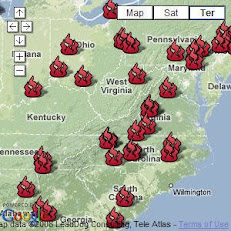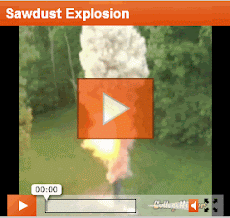When milling, machining, polishing, grinding, or drilling
materials such as Titanium, Magnesium, Aluminum, Iron Oxides, Stainless Steel,
and Carbon Fiber, manufacturers must address the inherent explosion and fire
hazards associated with the combustible dust generated by these materials.
NFPA 484 Annex // A.3.3.6.1
Combustible Metal Dust.*
3.3.6.1* Combustible
Metal Dust. “A
combustible particulate metal that presents a fire or explosion hazard when
suspended in air or the process specific oxidizing medium over a range of
concentrations, regardless of particle
size or shape.”
An overall system solution must address the process
requirements, materials, and the volumes processed. All equipment in contact
with hazardous / combustible dusts must be constructed in compliance with
HazLoc Class II disciplines, and
applicable N.F.P.A., A.N.S.I., and
A.S.M.E. standards. Customized systems
are usually application specific and sized appropriately for the collection,
conveyance, and control of the materials, ratios, and anticipated volumes of
debris to be recovered.
A basic understanding of the issues and solutions as
relate to current developments in systems configurations, and best industry
practices requires an explanation as to how catastrophic events occur. In the interest of enhanced worker and plant
safety we will also review what can be done to prevent them.
FIRE:
Direct:
Combustible dust related fires
occur in all cases as a result of combustible materials being exposed to an
ignition source. This can occur either
during or subsequent to machining when materials are within ignition
sensitivity levels capable of supporting a deflagration.
During Transfer:
When being transferred for
collection, combustible dusts can also impact duct work elbows and other
constrained joints and as a result of high speed impact create a spark moving
the ignition source toward a collection point.
Non-grounded components accumulating an electrostatic charge, exposure
to electrical motors or other spark producing equipment can also provide an
ignition source.
Collected:
If an ember or spark is eventually
transferred to a collection location and maintains ignition energy it can
initiate a further transfer of the ignition to additional materials in the
process stream.
Accumulated Residuals:
Layers of dust which have
accumulated over time have also been documented as transmitting an initial deflagration
to secondary areas. In a worst case scenario if suspended as a dust cloud,
explosions are easily generated as the deflagration gains rapid expansion due
to the increase of combustibles.
EXPLOSION:
Suspension:
Dust explosions occur when combustible materials are
suspended in an air/fuel concentration consistent with rapid ignition
transmission. If the initial deflagration generates even a primary explosion,
the associated shock waves will dislodge any dusts which have accumulated over
time on overhead beams, walls, duct work, machinery, or collection vents. When
these materials are dislodged from their resting place, they become airborne
and in the presence of the initial flame front ignition source presented by the
initial deflagration, they will contribute to an even much larger secondary
catastrophic explosion. Incidents
reported in recent years here in the U.S. have documented multiple
deaths, injuries, and significant property destruction.
S.D.S. (SAFETY DATA SHEETS) seldom refer to the inherent
danger of finite dust particles generated during machining processes. They fall
short by NOT expressing the M.I.E. (Minimum Ignition Energy) and minimum
ignition temperature (MIT) thresholds and seldom address the issue of
reactivity with other materials. In some
industries such as aerospace, there are usually several materials in a waste
stream. As an example, drilling and
assembling aircraft structures will generate carbon fiber, titanium, aluminum,
and stainless steel in varying combinations.
These comingled materials lead to secondary handling issue that S.D.S.
specifications don’t address. Using one collection system for recovering
different materials from diverse operations should be evaluated by sample
testing to determine if a volatile combination of materials with lower MIE than
each by themselves may be present.
HOUSEKEEPING:
Housekeeping,
provides increased worker and plant safety but usually adds to the overall cost
of manufacturing operating expenditures. Safely removing accumulated combustible dusts
requires specialized equipment and in some cases access can only be achieved if
entire production areas are shut-down.
As a result, cleaning activities are not performed as frequently as they
should be thus increasing the risks associated with accumulated combustible
dusts. To minimize personal risks, efforts should include materials safety
awareness, safe handling protocols and training. For example, using plant
compressed air to “blow-off” debris from recessed areas should be avoided as
the resultant dust in suspension could easily propagate an explosion under the
right conditions.
TESTING:
When dealing with any of the debris generated within the
production waste stream, one of the first steps must include combustible dust
testing of the materials for explosive severity and ignition sensitivity as
they would be generated in the work environment. Sample collection(s) and submittal to an
independent laboratory for testing under N.F.P.A. Code 68 is essential. Data
received from such test results is mandatory when designing fire prevention and
explosion protection equipment and process systems with sufficient capacities
to safely accommodate subsequent collection, conveyance, and containment of the
materials being recovered.
A PRO-ACTIVE SOLUTION: COLLECT – CONTROL –
CONTAIN
.jpg) |
| Central Vacuum System |
Current systems have incorporated both high volume air
flow AND high vacuum to optimize collection efficiencies and transfer
capabilities of heavy combustible dusts.
The ability to collect and control the transfer of any debris or dust is
related directly to the volume, size, weight, specific gravity, and surface
area of the material to be addressed.
Vacuum in itself provides no means to act upon any material unless there
is substantial air volume available to generate the motive force behind
transfer. Dust collectors generally rely
upon large volumes of air flow and as a result impart minimal vacuum on
materials to maintain their velocities in collection ducts.
Collect dust as it is being generated.
Hazardous dust migration in many cases has been eliminated
by using specialized high volume – high vacuum
/ dust recovery systems to collect debris simultaneous to generation
further containing the recovered materials and minimizing the burden of
house-keeping. Within the aerospace industry, complete recovery of drill chips
and dust at the work piece is currently in use on several projects and in
automotive applications, debris recovery has been accomplished within assembly
and machining operations with the same process.
Control dust during transfer:
The recovery of combustible particulate solids must assure
that air/material ratios never approach critical M.E.C. (Minimal Explosive
Concentrations) which could support ignition resulting in a deflagration which
could travel either up or down stream of the event. M.E.C. ratios vary based on
materials and process requirements, however the speed at which materials are
transferred and the separation of these materials by excessive air volumes
provides a means to isolate one particle from the next. High volume rate
transfer also maintains the materials in suspension which minimizes their
contact with duct work thus reducing the build-up of fines, clogs, static, and
sparks
Contain dust for safe disposal:
Many terms apply to the initial separation of the
combustible dusts from the recovering air stream such as Vortex, Centrifugal,
or Gate type systems. Initial contact between recovered dusts and the receiving
receptacle act to slow the materials in the air stream such that heavy
materials drop out of the airstream before contact with any filtering media.
General dust collectors employ filter “bag-house” configurations with high
pressure air jets to back flush the filters on occasion to maintain collection
capabilities as the finer materials in these type systems have a tendency to
migrate into the filter media. Rotary valves or gates at the bottom of the
recovery receptacles allow recovered materials to be collected for disposal.
SYSTEM
FEATURES:
Items which may have been considered as “OPTIONAL” in the
past should be considered as MINIMAL requirements in systems collecting and
conveying combustible dusts in compliance to HazLoc Class II. Terminology may differ between industries and
suppliers however the intent to which these are applied remains consistent with
providing safety in the work place.
Specifically best industry practices include:
Grounding – and incorporating non-spark producing
elements, materials, motors, switches
Spark / Heat detection – includes multiple high
temperature rise sensors
Explosion detection – detect first pressure wave of an
initial explosion ( see isolation below )
Explosion venting – pressure relief and / or rupture disk, vents explosion toward a safe area
Flame / Fire / Deflagration Suppression – appropriate to the material(s)
being encountered
Flameless venting – prevents flame travel beyond location
of occurrence
Isolation-Explosion gates – prevents flame travel
“up-stream” or to other process areas
Minimized debris contained for safe daily removal
Plant personnel education, awareness and training
Author: J. Byron Walker is Director for Systems Design and Engineering @ TECH TRANS UNLIMITEDCORP. He has over 35 years of experience
in Robotics and automation systems integration working in the automotive,
aerospace, and electronics industries.
He holds patents in finite parts cleaning technologies and is
responsible for providing total systems solutions for the safe recovery and
transfer of Hazardous Materials to which this article is directed.
.jpg)










 RSS Feed Subscribe
RSS Feed Subscribe